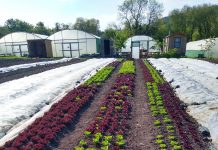The last few months have been a veggiehead’s dream, with warm nights, warm soil, good light levels and just enough rain.
Every inch here has been taken up by growing crops, even the potatoes have no blight yet, and it’s been the best year for outdoor tomatoes ever.
As we now approach winter, you can transplant salad crops from modules such as spinach, land cress, coriander and dill. Or even, if it stays mild, try sowing seeds—they will come up slowly even as the days darken, but you may have a crop by the new year if your slugs are kind. Or when a crop is finished, such as sweetcorn or dwarf beans, our much-loved winter squash planted nearby soon grow into their place.
The nights have been so warm we have been tempted into thinking there may be another warm winter(!) We have even been transplanting bulb fennel, as there are now varieties of fennel, such as Sirio which, while they do not like ongoing frost, seem able to grow on and bulb up until Christmas. Turnip transplants also, especially if you like them small.
These mild winters persuade me to plant October sowings towards the end of the month or even early November. These include Aquadulce broad beans, garlic and overwintering onion sets. The mild winter last year may be the reason that our garlic was ready to pick by mid-June rather than the usual July.
As bare soil opens up, growing green manure springs to mind. Sow some cheap seed such as mustard, which a good frost should kill, so that by next spring they will have trotted down a treat. You don’t need to dig them in—digging is bad for soil structure, kills worms and is wasted effort. If they don’t die but start flowering, hoe them through and put stemmy stuff on your compost heap.
If you have lots of weeds germinating, pull them all out and cover with a thick layer of compost. This will have rotted down by April to a perfect sowing tilth. If you see weeds coming up through then hoe them, which also helps break down any lumps.
Some feel obliged to use black plastic as a mulch. If you have to, use some old plastic—not new, that’s wasteful. While this can warm up the soil in spring, that heat disappears before the next crop germinates. We find fleece better over a seedbed as it seems more and more necessary because our feathered friends are forever scratching freshly sown seedbeds. Fleecing was the only way we could get our carrots to come up this spring. This also applies to plantings of garlic and onion sets, as the birds are attracted by the disturbed soil and bright colours of the garlic.
As bare soil appears indoors after tomatoes and peppers, we will be sowing carrots—which want plenty of moisture to germinate—and winter salads such as the wonderful Red Frills mustard, Winter Gem lettuce and true spinach. Transplants of coriander or dill too, or even a new sowing, which may give you a crop of leaves by spring.
Having said all this, we will probably have a hard winter. But what did the mother strawberry say to the little strawberry? Don’t get into a jam.








